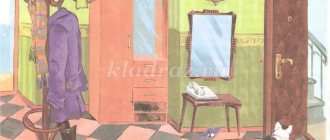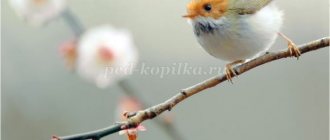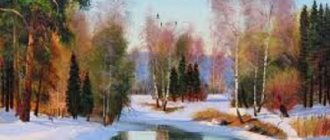Abstract of the educational activity “Journey to the winter forest” (educational field “Cognition”)
Goal: To develop children’s knowledge about wild animals.
Tasks:
1 . Educational: - to consolidate children’s knowledge about the appearance and habits of wild animals in winter, through play-based learning situations; - develop the ability to distinguish and name animals (squirrel, fox, hare, bear); 2 . Developmental: - develop children’s speech when answering the teacher’s questions, memory, motor activity; read poems about animals, solve riddles; - activate children's vocabulary: fluffy, soft, warm, den, hollow, bark; 3 . Educational: -Create a desire in children to participate in a conversation (conversation) with the teacher. -Cultivate a kind, sensitive attitude towards wild animals. — Stimulate attention and endurance with the help of visual material.
Materials and equipment: Decoration: clearing in the winter forest, den, fir trees, stump. Toys: soft squirrel, fox, bear, hare; a snowman doll, a basket with treats for the animals, and the game “Spread out in the houses.”
Preliminary work: Examination of paintings, illustrations about wild animals; Reading the works of V.V. Bianchi "The Sly Fox and the Smart Duck" E. Charushina “Bear - Head”, “Wolf”, “Fox and Mouse”; r.n.s. “Sister Fox and Gray Wolf”; "Three Bears", "The Fox and the Hare"; Poems by I. Tokmanov “Bear”; telling riddles about wild animals; didactic - printed games “Forest inhabitants” (lotto), “Whose children?”, “Who lives where?”; drawing, modeling, coloring animals.
Integration of educational areas: “Cognition”, “Communication”, “Reading Fiction”, “Socialization”, “Physical Education”
GCD move:
1. Organizational point:
Educator: Makes a riddle:
Snow on the fields, ice on the rivers. Blizzards, when does this happen?
Children: In winter!
2. Practical part:
Educator: Correct. Yes, there is a lot of snow outside, it has become cold, the sun is shining less often, the trees have lost their leaves, and the snow has fallen, hiding the grass in the forest too.
I wonder what is happening in the forest now?
Let's go with you to the winter forest. Let's take a basket with gifts for the animals with us, in case we meet them there. To do this you need to close your eyes and say:
“Turn around yourself in the winter forest and find yourself!” (children pronounce the words, open their eyes, at this time a phonogram of a recording of the voices of forest birds sounds).
Educator: Guys, listen, the winter forest is quiet and calm. Winter covered the forest with fluffy snow.
White fluffy snow swirls in the air and quietly falls to the ground and lies down (Children walk slowly into the forest. There is a forest clearing ahead. In the clearing, on a stump, there is a snowman.)
Educator: Oh, guys, look who meets us in the forest? Who is that sitting?
Children: Snowman, (greets everyone) the children also greet him.
Educator: Why are you so sad, snowman? What's happened?
Snowman: It’s quiet here, there’s no one to talk to, and you won’t see any familiar animals.
Educator: Come with us, we wanted to see the winter forest, and also see how wild animals live in the forest. Will you come with us?…
Snowman: Yes.
-Guys, who is this? I don’t recognize him.
Children: Hare.
Snowman: Indeed a hare. Why is he white? What happened to him?
Educator: Guys,
Why did the hare put on a white fur coat? Where does the bunny hide in winter? Why? (Under a bush) What does a bunny eat?
Children: bark, twigs, dry grass.
Educator: Who knows a poem about a hare?
The child recites the poem:
A long-eared, nimble bunny eats leaves on the lawn. And the little bunny hid. He is afraid of everything in the forest.
Educator: Let's treat the bunny with a carrot. (We treat the bunny). -Now let's move on Guys: Look how many shells there are. Who dined here? (Children approach the Christmas tree, there is a squirrel sitting there).
Children: Squirrel.
Educator: That's right, it's a squirrel.
What supplies does the squirrel prepare for the winter? (Nuts, mushrooms, apples). Where does a squirrel hide its supplies? (Into the hollow).
A child recites a poem about a squirrel:
The squirrel collects cones and stores mushrooms. Two little squirrels are always in a hurry to help her.
Educator: Oh yes squirrel, oh yes busybody!
Educator: What kind of fire is burning between the trees? Who is that lurking there?
Children: Fox.
Educator: Correct. And what kind of fox? (Cunning, red-haired, beautiful, cheat).
What does a fox like to eat?
Children: chickens, fish, hares and mice.
Educator: Let's listen to a poem about a fox.
The child recites the poem:
The red fox loves to profit from fresh fish. And the little fox on the hill catches the mouse near the hole.
Educator: Let's treat the fox to a fish so that she becomes kind. (Children treat the fox)
Educator: Let's continue our journey.
Snowman: What kind of slide is this?
Educator: Children, I hear someone snoring there. Guess who I'm talking about:
Who is furry and big and walks through the forest in the summer? Does he rest in a den in winter?
Children: Bear.
That's right, bear.
Like snow on a hill, snow. And under the hill there is snow, snow, And on the tree there is snow, snow, And under the tree there is snow, snow. And a bear is sleeping under the tree - Quiet, quiet - don’t make noise.
What does a bear do in winter? (Sleeping).
Who will tell a rhyme about a bear?
The child recites the poem:
The brown bear lives without worries with the cubs. There are raspberries and fragrant bee honey for them in the forest.
Educator: What does a bear like to eat? (Honey, raspberries, fish).
Let's leave the honey here so that the bear has something to eat if he suddenly wakes up.
Shall we show you how bears walk?
Physical exercise: “Three Bears”
Three bears were walking home - The children waddle in place. Papa Bear was big - Raise your hands up. Mom is a little shorter - They lean forward. And the little son just - Squats. He was very small and walked around with rattles - Children imitate playing with rattles. Tink - ding - ding he walked with rattles. (We leave the container with honey and move on; on the stump lies the game “Settled in the houses”).
Educator: Oh, guys, look, someone left the game, let's play now. Look how many kids there are, let's help them find their home. Who lives in which house? Where's the little fox? (In the hole). Where's the bunny? (Under a bush). Where's the teddy bear? (In the den). Well done!
Educator: Look guys, what a wonderful clearing, how much snow there is and someone’s ears can be seen.
Children: This is a bunny.
Educator: Guys, he’s probably very cold, look, he’s shaking all over, let’s play with him.
Game "It's cold for the bunny to sit."
The little white bunny is sitting - the children squat down, hands above their heads, and wiggles their ears - the bunny's ears are cold. The little bunny sits cold - they stand up, clap their hands. We need to warm our little paws. It’s cold for the bunny to stand - the children jump on two legs. The bunny needs to jump. Someone scared the bunny - they crouch down and cover their face with their palms. The bunny jumped and hid.
Educator: So our bunny has warmed up.
Guys, we have been in the forest for a very long time, it’s time for us to return to kindergarten. Let's say goodbye to the snowman, tell him goodbye. Cover your eyes with your palms and say: “Turn around yourself, find yourself in kindergarten” (Children close their eyes and repeat the words).
3. Reflection.
Guys, where have we been? (In the winter forest).
Did you like it in the forest?
Who did we meet in the winter forest? (Squirrel, hare, fox).
What other animals live in the forest that we haven’t met? (Elk, beaver, wolf, hedgehog). Who will tell a poem about them?
What animals are these? (Wild). Why? (Because they live in the forest). Thank you everyone worked well today.
Author: Poduzova Olga Nikolaevna teacher, MAOU gymnasium No. 2 SP "GDO" Asino, Tomsk region, Russia
The article is published in the author's edition
Lesson summary “Forest - multi-storey building”
MBDOU No. 5 “Scarlet Flower”, Tikhoretsk, Krasnodar Territory
Educator
Winner (1st degree diploma) of the All-Russian competition for teaching staff of preschool organizations “Best lesson notes in kindergarten”
Link to the article, when indicated in the bibliography (according to GOST R 7.0.5-2008):
Posokhova S.B. Lesson summary “Forest - multi-storey building” // Sovushka. 2015. N1. URL: https://kssovushka.ru/articles/e-sovushka.2015.n1.00010.html (access date: 02/05/2022).
Goal: to clarify and expand children’s ideas about the forest and its inhabitants.
Tasks :
- give children an initial idea that a forest is a multi-storey building in which many plants and animals live on different “floors” (tiers), which find food, places for nests, and burrows in it;
- show the multi-tiered nature of the forest;
- identify and enrich children’s ideas about the importance of forests in human life;
- give children an idea of a forester - a person who takes care of the forest: protects from fire, feeds animals in winter, saves some of them from harm;
- develop children's cognitive interest, respect for nature, and correct behavior;
- to cultivate interest in nature, the ability to see its beauty, the desire to preserve all living things.
Preliminary work:
- conversation about the forest;
- examination of illustrations depicting the forest and the album “Beasts of the Forest”;
- learning proverbs about the forest;
- guessing riddles about forest animals;
- looking at illustrations depicting a forester.
Materials:
- model “floors of the forest”, pictures depicting trees, bushes, mushrooms, berries, forest inhabitants;
- tables; pictures “How a forester takes care of the forest”, “Rules of conduct in the forest”, “Why do people go to the forest.”;
- musical accompaniment.
Methodological techniques : asking riddles, playful actions of placing animals on the floors on the diagram, filling out tables, asking questions to children, assessing and rewarding, listening to musical recordings, viewing slides.
Equipment: multimedia installation, tape recorder.
PROGRESS OF THE CLASS
Educator: Guys, today we will go on a trip in a hot air balloon, and you will find out where along the way (the teacher offers to take the children’s seats). While we are flying, I will tell you a riddle, and you will guess where we will go.
The hero is rich and treats all the children: Vanya with strawberries, Tanya with stone fruits, Mashenka with nuts, Petya with russula, Katenka with raspberries, Hooligan with twigs.
Children : into the forest. Educator: that's right, this is a forest. While you and I are flying into the forest, let's see how many interesting things you can see (view multimedia slides, ask the children how everything looks from above, bring up the fact that from a height everything seems small, only the roofs of houses are visible) Educator : Listen ... Hear the breeze playing with the leaves. But the voices of birds were heard (the voices of birds sound) Do you hear? Xin-xin-xin is the song of a tit, cha-cha-cha is a magpie, chiv-chik-chik-chirik is a sparrow. We are approaching the forest (music sounds). Children, can we say that we heard the voice of the forest? Why? (children's answers) Educator: Now we have arrived in the forest, let's get out of the balloon. Hello, forest, dense forest, full of fairy tales and miracles. Look how many trees, mushrooms, and bushes there are in the forest. How many colors... Red, burgundy color can be found in mushroom caps and ripe lingonberries and cranberries. Yellow and orange colors are given by forest daisies and butterflies. You will find the color green in grass, leaves and mischievous grasshoppers. Blue - in the expanses of heaven and clear waters. The blue color is hidden in forest clearings in cornflowers and bluebells. And the purple color is about to fly away on the wings of a beetle (Slides showing a forest on a multimedia installation are shown). Educator : Who do you think are the most important inhabitants of the forest? Children : trees Educator: That's right, trees. What trees grow in the forest? (slides with images of trees are shown and their names are clarified). Educator: Guys, here are pictures of trees, try to name them (the children name the trees, the teacher asks how they knew that it was birch, oak, spruce, etc.) Educator: What else grows in the forest? (children's answers: bushes, berries, mushrooms, grass...) Educator: Who do you think needs trees, grass, shrubs and mushrooms and why? (children's answers: animals, birds, insects...) Educator: That's right, different animals live in the forest: animals of prey (wolf, fox, bear, lynx), forest birds (magpie, nightingale, owl, woodpecker), insects (ants, beetles) , caterpillars, mosquitoes). Educator: Can a forest be called a multi-story building? (children’s answers) Educator: Let us now create your own forest (a picture of a forest is assembled on the panel) Educator: Now let’s compare the forest with a multi-story building (a table with a picture of a multi-story building is inserted into the table-panel “Forest”, a line is drawn from each floor , passing through the panel) Educator: What grows on the first floor? (children's answers: grass, mushrooms, flowers....) Educator: What grows on the second floor? (children's answers) Educator: That's right, the next floor is occupied by smaller bushes and trees, and the topmost floor is occupied by tall oaks and pines. All floors are inhabited by forest inhabitants. Tell us which forest inhabitants live on which floor? (children's answers) Educator: A forest is like a large multi-story building. There are many, many tenants and neighbors living there. They all need each other (Slide show - multi-tiered forest) Educator: Guys, which of you lives in a multi-story building? (children's answers) Educator: Now you know that not only a house, but also a forest can be multi-story (check with the children what grows and who lives on different floors of the forest) Educator: Do you think a person needs a forest? (children's answers) Educator: The forest is a wonderful natural resource. People go there not only to pick mushrooms and berries, they go to the forest to relax, enjoy the silence, coolness, clean air, birdsong, forest rustles (work with a table - children are offered pictures, from which they need to choose those that show why a person goes to the forest Children choose pictures and paste them into the table) Educator: Children, do you think the forest can be offended? (children's answers) Educator: A plaintive book of the forest fell into my hands. (children look at a book of complaints, the teacher reads out complaints from flowers, birds, etc.) Educator: How can you help the forest? (children's answers) There are pictures on the table depicting what should not be done and how you can help. Educator: I have prepared 2 tables for you: on one the flower is smiling, and on the other it is sad. Why do you think? (children's answers: the flower is sad - this should not be done in the forest, smiles - how can we help the forest). Educator: Let's choose pictures for ourselves and fill out the tables. (Children fill out a table about the rules of conduct in the forest) Educator: Well done! Remember these rules and follow them. Guys, we told you that the forest is a big house. Every house has an owner. Do you know who is the main owner in the forest? (children's answers) Educator: That's right, the main person in the forest is the forester. He knows all the inhabitants of the forest well and tries to help them in difficult times. He makes sure that the trees do not get sick, extinguishes forest fires and plants new trees to replace those cut down. There are not so many foresters in our country; the work of a forester is difficult and sometimes dangerous. He lives in the forest far from the city. Let's see how a forester takes care of the forest (look at the table). Educator: Guys, think about whether ordinary people can help the forest and forest inhabitants? How? (children's answers) Educator: Well done. You and I talked a lot about the forest, its inhabitants, the rules of behavior in the forest, the necessity of the forest for people, and the work of a forester. And now it’s time for us to say goodbye to the forest:
Dense forest, goodbye! You will grow to the joy of people! We will be friends with you, kind forest, mighty forest, Full of fairy tales and miracles!
Educator: Let's get into our balloon and go back to kindergarten (children take their seats). Educator: In the meantime, tell me why the forest is called dense and mighty? (children’s answers) Educator: What does it mean “you will grow up to please people”? Educator: Why do you think the forest is full of fairy tales and miracles? (children’s answers) Educator: You and I didn’t notice how we arrived (children get out of the balloon). We are back in kindergarten. Educator: Did you like our trip? What did you like most? (children's answers) Educator: Now you know that a forest is a multi-story building in which many plants and animals live on different “floors” and find food, places for nests, and burrows in it. You know the rules of behavior in the forest and that the main person in the forest is the forester.




